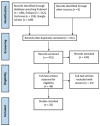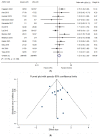Left Atrial Appendage Thrombosis and Oral Anticoagulants: A Meta-Analysis of Risk and Treatment Response
- PMID: 36286303
- PMCID: PMC9604359
- DOI: 10.3390/jcdd9100351
Left Atrial Appendage Thrombosis and Oral Anticoagulants: A Meta-Analysis of Risk and Treatment Response
Abstract
Background: Left atrial appendage thrombus (LAAT) is the main cause of cardioembolism in patients with nonvalvular atrial fibrillation (AF). Emerging evidence indicates that direct oral anticoagulants (DOACs) may be a preferred, safer choice for patients with LAAT. However, current guidelines indicate vitamin K antagonist (VKA) as the preferred treatment for LAAT. We conducted a meta-analysis to compare the efficacy of VKA and DOAC for the treatment of LAAT. Methods: The search was conducted in the PubMed, Embase, Google Scholar, and Cochrane Library databases from inception to July 2022, with the language restricted to English. A first analysis was conducted to evaluate the risk of LAAT under VKA or DOAC treatment. A second analysis was conducted to compare the resolution of LAAT under VKA and DOAC treatment. Results: In 13 studies comparing LAAT incidence rates under VKA and DOAC treatment, significant superiority of DOAC was detected (pooled RR = 0.65, 95% CI = 0.47-0.90, p = 0.009) with moderate heterogeneity being identified in the pooled studies. In 13 studies comparing LAAT resolution under VKA and DOAC use, treatment with DOAC exhibited a significantly increased probability of LAAT resolution compared with VKA (pooled odds ratio = 1.52, 95% CI = 1.02-2.26, p = 0.040). Conclusions: This meta-analysis suggests a superiority of DOAC over VKA with respect to LAAT incidence in people with AF and the likelihood of LAAT resolution. Due to their established safety profile, DOAC is a preferable choice for anticoagulation, although further randomized controlled studies are warranted to provide further evidence of their suitability as a new recommended treatment.
Keywords: atrial fibrillation; left atrial appendage thrombus; oral anticoagulant; stroke.
Conflict of interest statement
The authors report no conflict of interest.
Figures




Similar articles
-
Incidence of left atrial appendage thrombus despite 3 weeks of anticoagulation and the need for precardioversion echocardiography.Ann Noninvasive Electrocardiol. 2022 Sep;27(5):e12989. doi: 10.1111/anec.12989. Epub 2022 Jul 8. Ann Noninvasive Electrocardiol. 2022. PMID: 35802810 Free PMC article. Review.
-
The efficacy and safety of direct oral anticoagulants compared with vitamin K antagonist in patients with hypertrophic cardiomyopathy and atrial fibrillation.Thromb J. 2024 Jan 2;22(1):2. doi: 10.1186/s12959-023-00562-8. Thromb J. 2024. PMID: 38166972 Free PMC article. Review.
-
Left Ventricular Ejection Fraction Is Associated with the Risk of Thrombus in the Left Atrial Appendage in Patients with Atrial Fibrillation.Cardiovasc Ther. 2020 Apr 24;2020:3501749. doi: 10.1155/2020/3501749. eCollection 2020. Cardiovasc Ther. 2020. PMID: 32411299 Free PMC article.
-
Risk stratification of patients with left atrial appendage thrombus prior to catheter ablation of atrial fibrillation: An approach towards an individualized use of transesophageal echocardiography.J Cardiovasc Electrophysiol. 2017 Oct;28(10):1127-1136. doi: 10.1111/jce.13279. Epub 2017 Jul 26. J Cardiovasc Electrophysiol. 2017. PMID: 28635023
-
Uninterrupted anticoagulation during catheter ablation for atrial fibrillation: no difference in major bleeding and stroke between direct oral anticoagulants and vitamin K antagonists in an updated meta-analysis of randomised controlled trials.Acta Cardiol. 2021 May;76(3):288-295. doi: 10.1080/00015385.2020.1724689. Epub 2020 Feb 14. Acta Cardiol. 2021. PMID: 32056498
Cited by
-
Left Atrial Appendage Thrombus in Low CHA2DS2VASc Score in Persistent Atrial Fibrillation.Cureus. 2025 Mar 25;17(3):e81160. doi: 10.7759/cureus.81160. eCollection 2025 Mar. Cureus. 2025. PMID: 40276422 Free PMC article.
-
A case report of a giant coronary artery aneurysm masquerading as a ventricular mass.Eur Heart J Case Rep. 2024 Mar 12;8(4):ytae124. doi: 10.1093/ehjcr/ytae124. eCollection 2024 Apr. Eur Heart J Case Rep. 2024. PMID: 38572017 Free PMC article.
-
New Perspectives on Risk Stratification and Treatment in Patients with Atrial Fibrillation: An Analysis of Recent Contributions on the Journal of Cardiovascular Disease and Development.J Cardiovasc Dev Dis. 2023 Feb 2;10(2):61. doi: 10.3390/jcdd10020061. J Cardiovasc Dev Dis. 2023. PMID: 36826557 Free PMC article.
-
Association of Body Mass Index with Echocardiographic Parameters and Incidence of Left Atrial Thrombus or Spontaneous Echo Contrast in Patients with Nonvalvular Atrial Fibrillation: A Cross-Sectional Study.Rev Cardiovasc Med. 2024 Dec 31;26(1):26014. doi: 10.31083/RCM26014. eCollection 2025 Jan. Rev Cardiovasc Med. 2024. PMID: 39867203 Free PMC article.
-
Mean Platelet Volume as a Predictor of Left Atrial Appendage Thrombus Resistance to Lysis in Patients With Atrial Fibrillation: Results of a 12-Month Follow-Up.Rev Cardiovasc Med. 2025 Jun 27;26(6):38943. doi: 10.31083/RCM38943. eCollection 2025 Jun. Rev Cardiovasc Med. 2025. PMID: 40630440 Free PMC article.
References
-
- Feigin V.L., Stark B.A., Johnson C.O., Roth G.A., Bisignano C., Abady G.G., Abbasifard M., Abbasi-Kangevari M., Abd-Allah F., Abedi V., et al. Global, regional, and national burden of stroke and its risk factors, 1990–2019: A systematic analysis for the Global Burden of Disease Study 2019. Lancet Neurol. 2021;20:795–820. doi: 10.1016/S1474-4422(21)00252-0. - DOI - PMC - PubMed
-
- Adams H.P., Bendixen B.H., Kappelle L.J., Biller J., Love B.B., Gordon D.L., Marsh E.E. Classification of subtype of acute ischemic stroke. Definitions for use in a multicenter clinical trial. TOAST. Trial of Org 10172 in Acute Stroke Treatment. Stroke. 1993;24:35–41. doi: 10.1161/01.STR.24.1.35. - DOI - PubMed
Publication types
LinkOut - more resources
Full Text Sources

